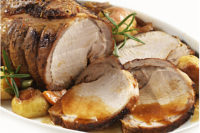National Pork Board uncovers what diners crave and why
Pork is the No. 1 consumed protein globally.

The National Pork Board, Des Moines, Iowa, released its findings from the comprehensive Insight to Action research, this time examining trends in consumer behavior related to dining out.
With a shifting dining out landscape and multicultural cuisine trends on the rise in the United States, the Pork Board set out to understand the needs, considerations and motivations that impact out-of-home dining decisions. The Pork Board's “All About Dining Out: What's on Trend” report uncovers why consumers decide to eat the proteins they do and explores tactics foodservice operators can use to explore new flavors, dishes and menu formats.
"With rapidly changing innovations, technology and competition, foodservice providers who truly understand what diners want – and deliver on it – will stand the test of time," says Steve Rommereim, president of the board of directors. "Consumer-driven insights are critical to our mission of increasing demand for pork. We want to spur innovation in collaboration with foodservice leaders and demonstrate that having more pork in more forms on more menus can increase consumer satisfaction and help drive operator profitability."
By knowing and understanding these behavior drivers, foodservice operators have an opportunity to develop new menu items and shift consumer experiences to give diners experiences that meet these primary needs.
"Pork is the No. 1 consumed protein globally, and yet fresh pork is the featured protein in less than 7% of entrée options when dining out in the U.S. That seems contradictory," says Jarrod Sutton, vice president of domestic marketing. "With the growing popularity of Asian and Latin cuisines where pork is a staple and a centerpiece, foodservice operators at every point on the spectrum have the opportunity to provide their customers with more flavorful and authentic options."
Some of the key consumer insights from the report include:
-
There are three primary drivers for consumer decisions. When considering where and what to eat when dining out, there are three primary drivers for consumers:
- Taste
- Health
- Convenience
- Consumers treat themselves. Consumers seek out menu options they don't usually make at home. One in four consumers (27%) consistently look for something new to eat, and they see dining out as an opportunity to treat themselves and indulge a little bit. Meanwhile, consumers don't keep pork on hand as often as other proteins. With it not being eaten at home as often, it can easily become that treat/indulgence they are looking for.
- Healthy options are still important. While health isn't the main reason people dine away from home, it's still important to consumers that menus have healthy options. Restaurants can expand the menu to include healthy pork options – like the pork tenderloin or the pork sirloin chop – in the same set as other healthy proteins, such as chicken and seafood. When health is the primary driver for a consumer's dining out decision, roughly six in 10 diners want a food that is "reasonably healthy," and roughly four in 10 want a food that fits their diet.
- Expand horizons. When asked what pork dishes people crave, 51% of consumers said they crave Mexican and Latin pork dishes and 45% said they crave Asian pork dishes.
- Make it easy, make it fast. Convenience was the primary need for consumers in 38% of away-from-home dining occasions. Consumers have high expectations for convenience when out to eat, and technology and the proliferation of on-the-go dining options have helped meet that need.
The National Pork Board commissioned custom research with C+R Research, Chicago, and Datassential, Chicago. The multi-phased custom studies surveyed 10,000-plus consumers and paired foodservice operator interviews, volumetric data and syndicated foodservice data to gain a comprehensive, in-depth look at the needs, offerings, considerations and motivations that impact out-of-home dining decisions of U.S. consumers
Looking for a reprint of this article?
From high-res PDFs to custom plaques, order your copy today!




